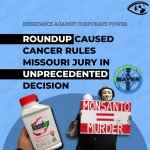Biotechnology's Third Generation
From Golden Rice to Anti-Viral Tomatoes -- Good Health or Good Marketing?
 As the international leaders prepare to meet in the Hague next week to discuss the UN Convention on Biodiveristy, activists are finding it difficult to get the biotech genie back in the bottle. Not even negative world opinion has slowed the development of a new generation of genetically modified plants and animals. The global controversy surrounding genetic engineering includes:
As the international leaders prepare to meet in the Hague next week to discuss the UN Convention on Biodiveristy, activists are finding it difficult to get the biotech genie back in the bottle. Not even negative world opinion has slowed the development of a new generation of genetically modified plants and animals. The global controversy surrounding genetic engineering includes:
Worldwide consumer skepticism -- and sometimes outright rejection -- of genetically modified (GM) foods
Growing opposition to Terminator and Traitor technologies which produce sterile seeds
Recent reports of GM maize invading Mexico's center of biological diversity
Yet none of these developments have made the pharmaceutical and agrochemical giants rethink their investment in biotechnology as the key to conquering all evils as well as many lucrative global markets.
"For many of us, the name biotechnology might at first seem intimidating," reassuringly notes the Council for Biotechnology Information, an industry group. "But if you look more closely, it is easy to see what biotechnology is, what it is doing, and what it can do to protect our environment, to help feed our expanding world population, and to foster the treatment and prevention of a wide array of diseases."
The Solution to Hunger and Malnutrition?
After giving us Round-Up Ready Soybeans and Starlink corn, the biotech industry is now offering Golden Rice as the magic bullet that will end malnutrition. This new GM rice, developed by government researchers in Europe, but owned by the Swedish-British AstraZeneca corporation (now Syngenta), has been engineered to contain beta-carotene which gives it a bright orange color. Beta-carotene turns into vitamin A inside the body.
According to the World Health Organization, nearly three million children under the age of five suffer from a severe vitamin A deficiency. Vitamin A helps fight tuberculosis, malaria, diarrhea and lowers child mortality(1).
Who, then, can possibly oppose the Golden Rice? Doesn't this new product prove that biotechnology can be used for good purposes? Biotech defenders answer a resounding "Yes!"
"Whether it's a new kind of wheat that is drought resistant, or corn loaded with more protein or a new strain of rice packed with Vitamin A, people who look at the entire world see biotechnology as a potential solution to the many problems the developing countries face, including food security and food safety," Cargill Chairman Ernest S. Micek in an address to the pro-business Economic Strategy Insitute's Global Forum.
But critics are not buying the biotech industry's assertion that its products are a panecea for the world's ills.
"Vitamin A deficiency is a symptom, a warning sign of broader dietary inadequacies associated with poverty and with agricultural change from diverse cropping systems to rice monoculture", says Peter Rosset co-director of Food First, an Oakland, California-based research and advocacy group.(2)
"People do not have vitamin A deficiency because rice contains too little vitamin A, but because their diet has been reduced to rice and almost nothing else. A magic-bullet solution that puts beta-carotene into rice -- with potential health and ecological hazards -- while leaving poverty, poor diets and extensive monoculture intact, is unlikely to make any durable contribution to well-being," according to Rosset.(3)
"The lower-cost, accessible and safer alternative to genetically engineered rice is to increase biodiversity in agriculture," argues Indian activist and scholar Vandana Shiva. "Further, since those who suffer from vitamin A deficiency suffer from malnutrition generally, increasing the food security and nutritional security of the poor-- by increasing the diversity of crops and therefore diets of poor people -- is the reliable means of overcoming nutritional deficiencies."(4)
Activist groups view golden rice not as a boon for the world's hungry, but as a public relations campaign for the biotech industry. "The real problem the industry seeks to address is not malnutrition but public opinion", says Charles Margulis, of the Greenpeace Genetic Engineering Campaign. "The propaganda value of yellow rice has been immeasurable, as industry has shamelessly used it in an attempt to quell growing US distrust of its experimental foods."(5)
Is genetic engineering really needed to fight world hunger? There are more than enough wild or underutilized highly nutritious plants that provide vitamin A and other nutrients. The combination of rice and moringa (drumstick) leaves, for example, has far more nutritional value than the golden rice. The moringa tree, native to India, grows abundantly in all tropical countries where vitamin A deficiency is a is a problem.(6) The grain amaranth has nine times more calcium than wheat, and 40 times more calcium than rice. It has four times as much iron as rice, and twice as much protein. The ragi millet, grown in India, has 35 times more calcium than rice, twice as much iron, and five times more minerals.(7)
Biotech Generation Three: Coming Soon to a Supermarket Near You
Golden Rice is just the spearhead of a new generation of biotech products, the so-called nutraceuticals, bioreactors, "pharm crops" or "functional foods." These new products are also known as biotech's Generation Three. The first generation refers the herbicide-resistant (Roundup-Ready) and biopesticide-producing (Bt) crops, which are now planted on tens of millions of acres of farmland. Generation Two consists of the proposed Terminator and Traitor technologies which genetically modify of plants to produce sterile seeds, forcing farmers to buy new seeds each year.
Unlike the previous two generations, Generation Three aims to be consumer-friendly: GM agricultural plants and farm animals with augmented nutritional content, or that produce industrial and pharmaceutical chemicals in their tissues. Novel products now being developed include an antiviral tomato, rice that produces human proteins for drug production, chickens that produce pharmaceutical drugs in their eggs, cavity-fighting fruits, and slow-growing lawns, among others.(8)
Citizens groups concerned about biotechnology advise the public not to get caught up in the functional foods hype. "While Generation Three could have far-reaching implications in the South and the North, the vast majority of these products will have little to do with feeding poor people or promoting sustainable agriculture" states the Action Group on Erosion, Technology and Concentration (ETC Group, formerly Rural Advancement Foundation International). "The target market is the affluent consumer Most functional foods of the future are not likely to be found in poor farmers' fields or in their cooking pots, but on supermarket shelves and in suburban kitchens".(9)
"Functional foods are about marketing, not health", says Marion Nestle, New York University nutrition and food studies professor. "My concern is that functional foods will distract people from eating healthy diets and encourage companies to market absurd products as heath foods because they contain one or another single nutrient."(10)
What are the potential dangers of Generation Three, beyond marketing unnecessary and silly products? Critics worry that crops that produce potent pharmaceuticals or industrial chemicals could get accidentally mixed up with the human food supply causing a potential threat to public health.
"How will crops that are engineered to produce industrial chemicals or drugs affect soil micro-organisms or beneficial insects?" wonders the ETC Group. "What if biopharmaceutical crops end up in animal feed? Will pharmaceutical proteins be altered in unforeseen ways? Could they cause allergies?"(11)
Some activists say Generation Three will increase potential hazards already faced by the public from currently existing GM crops. "Most noteworthy are problems of cross-pollination, and unknown deleterious effects on insects, soil microbes and other native organisms," according the Edmonds Institute, a Washington state-based think tank devoted to biotechnology issues. "Further, we may soon see biologically active enzymes and pharmaceuticals, only found in nature in minute quantities -- and usually biochemically sequestered in very specialized regions of living tissues and cells-- secreted by plant tissues on a massive commercial scale."
"The consequences may be even more difficult to detect and measure than those associated with more familiar GM crop varieties, and could escalate to the point where those now-familiar problems would begin to pale by comparison," the Institute warns.(12)
Activists say that without national or global rules regulating the development of biotechnology, by the time the consequences are felt it could be too late to reverse the damage.
Footnotes:
Genetic Resources Action International (GRAIN). "Engineering Solutions to Malnutrition". Seedling, March 2000.
Letter to The Nation, published in the July 16 2001 issue.
Ibid.
Vandana Shiva. "Genetically Engineered Vitamin A Rice". Included in "Redesigning Life? The Worldwide Challenge to Genetic Engineering". Brian Tokar, ed. Zed Books, 2001.
GRAIN. "Engineering Solutions to Malnutrition".
Vandana Shiva. "Stolen Harvest: The Hijacking of the Global Food Supply". South End Press, 2000.
Rural Advancement Foundation International (Now ETC Group). "Biotech's Generation 3". RAFI Communique, November 2000.
Ibid.
Ibid.
Ibid.
Edmonds Institute. "Biohazards: The Next Generation?". November 2000. 20319-92nd Avenue West. Edmonds, Washington, 98020, e-mail: beb@igc.org
Ibid.
Ruiz-Marrero is a Puerto Rican journalist and a Research Associate at the Institute for Social Ecology
- 122 Pharmaceuticals
- 181 Food and Agriculture



